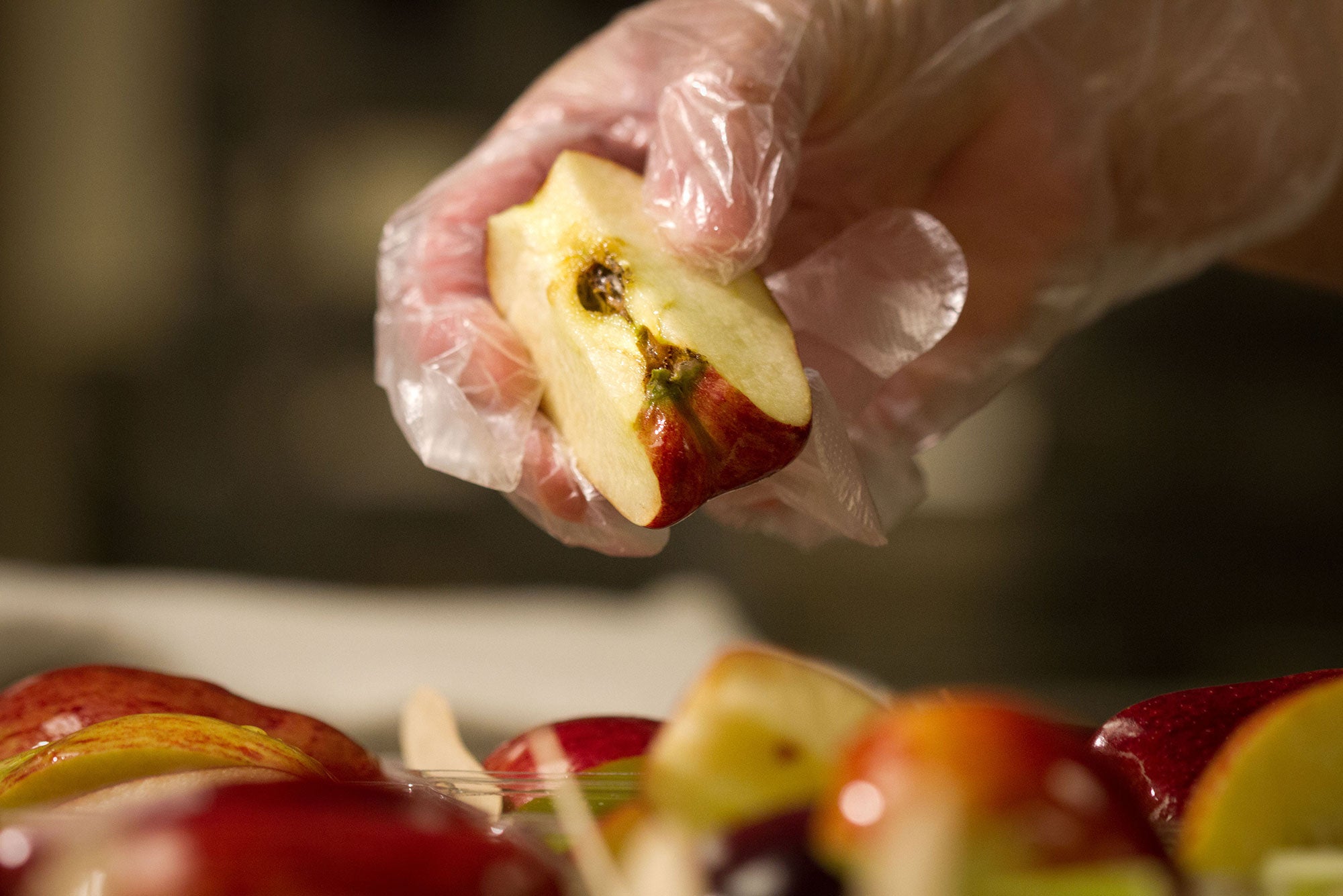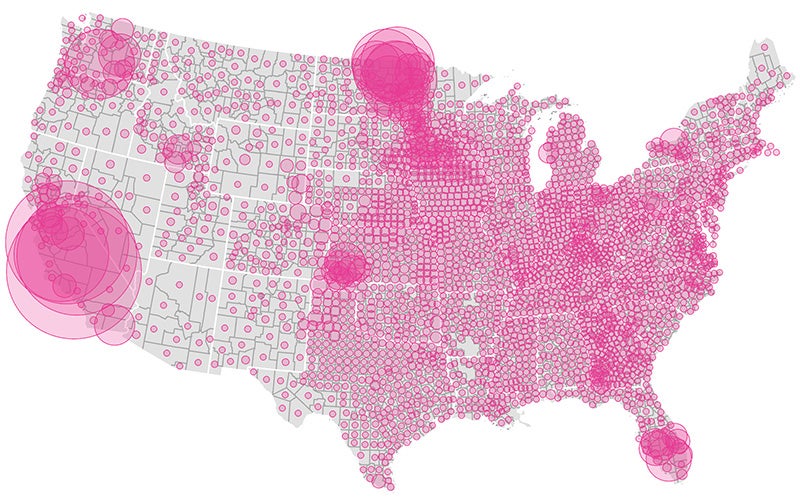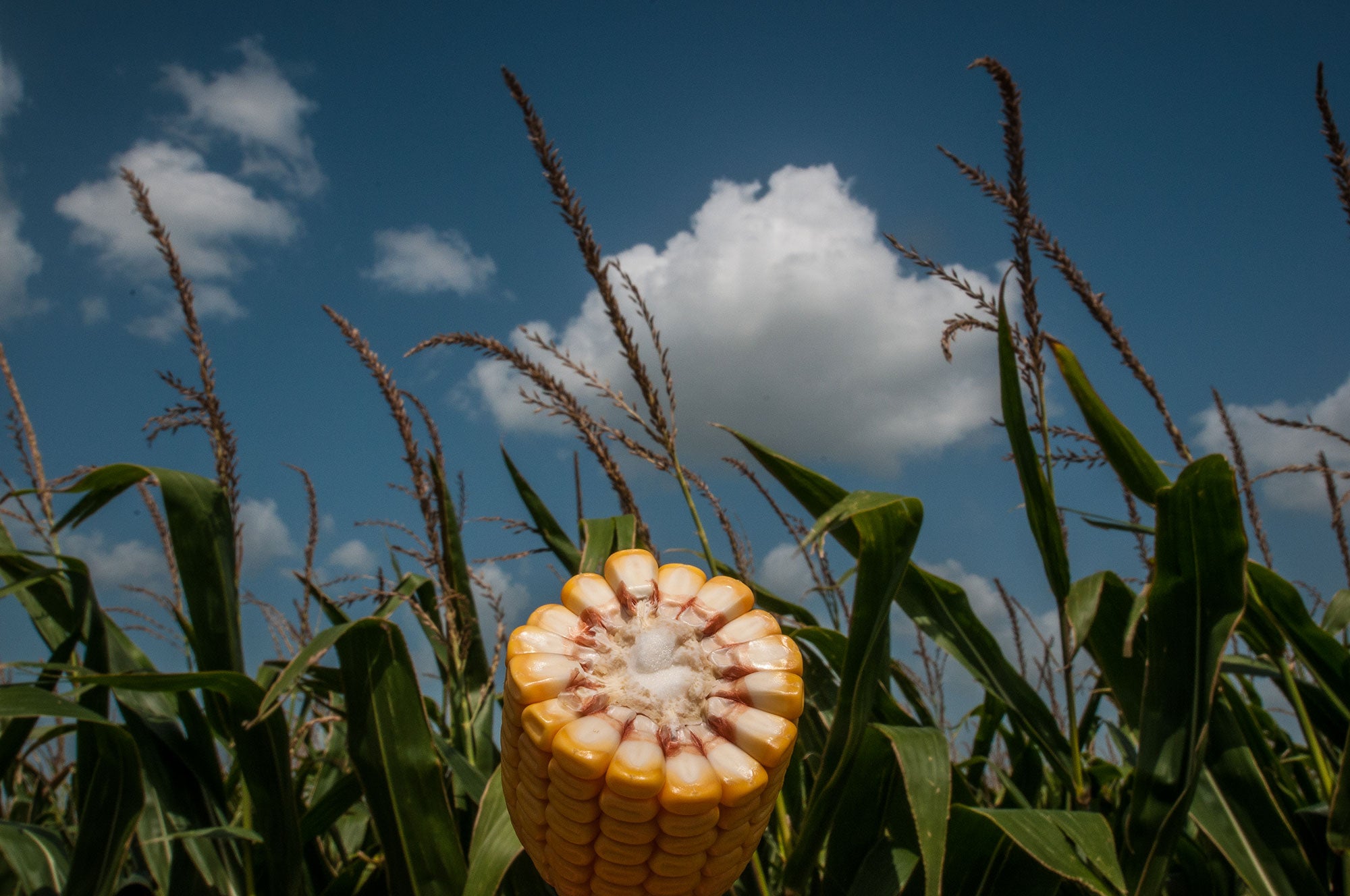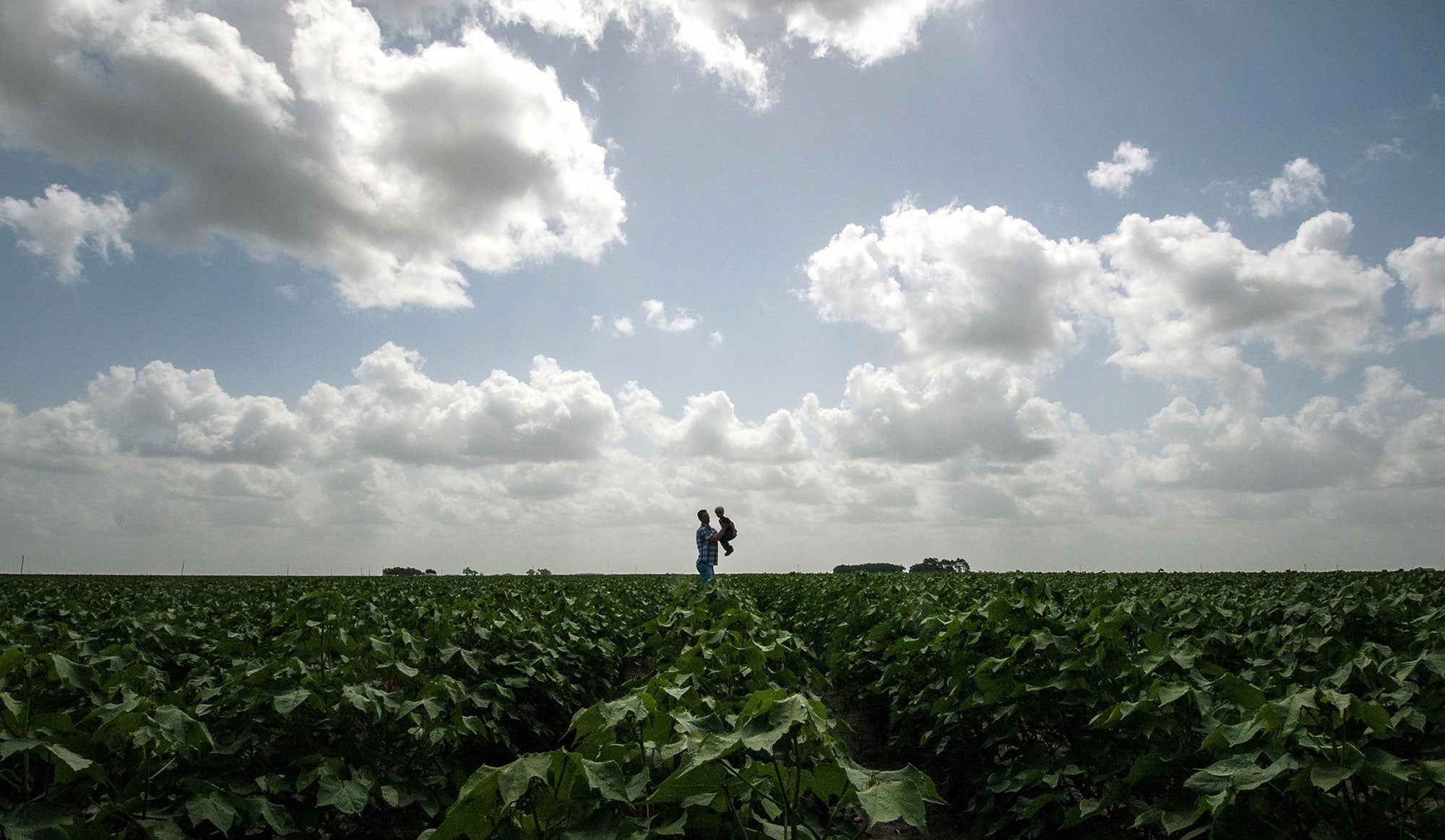The neurotoxic pesticide harms children and the environment.

For half a century, staple food crops in the United States — such as corn, wheat, apples and citrus — have been sprayed with chlorpyrifos, an organophosphate pesticide that can permanently damage the developing brains of children, causing reduced IQ, loss of working memory, and attention deficit disorders.
In a series of lawsuits, Earthjustice, alongside other groups, have long pushed the U.S. Environmental Protection Agency to ban chlorpyrifos.
Demand decisive action from the federal government — tell the EPA to follow the agency’s mandate to protect children, and reinstate the chlorpyrifos ban.
What is chlorpyrifos?
Chlorpyrifos (pronounced: klawr-pir-uh-fos) is a neurotoxic pesticide in the organophosphates class of chemicals that were first developed by the Nazis for chemical warfare.
Today, chlorpyrifos is widely used in U.S. agriculture. Generally sprayed on crops, it’s used to kill a variety of agricultural pests.
Chlorpyrifos is acutely toxic and associated with neurodevelopmental harms in children. Prenatal exposures to chlorpyrifos are associated with lower birth weight, reduced IQ, loss of working memory, attention disorders, and delayed motor development.
Acute poisoning suppresses the enzyme that regulates nerve impulses in the body and can cause convulsions, respiratory paralysis, and, in extreme cases, death. Chlorpyrifos is one of the pesticides most often linked to pesticide poisonings. (Read an in-depth report on chlorpyrifos.)
How are people exposed to chlorpyrifos?
Through residues on food and in drinking water, and by toxic spray drift from pesticide applications

People are exposed to chlorpyrifos through residues on food and in drinking water, and by toxic spray drift from pesticide applications.
Farmworkers are exposed to it from mixing, handling, and applying the pesticide; as well as from entering fields where chlorpyrifos was recently sprayed.
Consumers across the country are at risk, too, given chlorpyrifos’ widespread use. Residential uses of chlorpyrifos ended in 2000 after EPA found unacceptable risks to kids.
Children often experience greater exposure to chlorpyrifos and other pesticides because they frequently put their hands in their mouths and, relative to adults, they eat more fruits and vegetables, and drink more water and juice for their weight.

Why do we need to ban chlorpyrifos?
There are no safe uses for chlorpyrifos

A growing body of evidence shows that prenatal exposure to very low levels of chlorpyrifos — levels far lower than what EPA was previously using to establish safety standards — harms babies permanently.
Peer-reviewed studies that have tracked real-world exposures of mothers and their children to chlorpyrifos have associated the pesticide with similar findings.
EPA released a revised human health risk assessment for chlorpyrifos in 2016 that confirmed that there are no safe uses for the pesticide. EPA found that:
- All food exposures exceed safe levels, with children ages 1–2 exposed to levels of chlorpyrifos that are 140 times what EPA deems safe.
- There is no safe level of chlorpyrifos in drinking water.
- Pesticide drift reaches unsafe levels at 300 feet from the field’s edge.
- Chlorpyrifos is found at unsafe levels in the air at schools, homes, and communities in agricultural areas.
- All workers who mix and apply chlorpyrifos are exposed to unsafe levels of the pesticide even with maximum personal protective equipment and engineering controls.
- Field workers are allowed to re-enter fields within 1–5 days after pesticide spraying, but unsafe exposures continue on average 18 days after applications.
Farmworkers and people living in agricultural communities, particularly children, are disproportionately affected by this toxic pesticide. In addition to food exposures, they are more likely to have contaminated drinking water, and they are, quite literally, getting hit from all sides by drift exposures at school, daycare, on the playground, at work, and in their homes.
In this video, agricultural worker Claudia Angulo describes how her son Isaac suffered brain damage after she was exposed to chlorpyrifos during pregnancy. Since Isaac’s diagnosis with ADHD, she has worked to raise awareness among farm workers, the public, and politicians about the chemical's health effects.
Which crops have chlorpyrifos on them?
Apples, oranges, strawberries, corn, wheat, citrus, and more

Chlorpyrifos is used on a wide variety of crops including apples, oranges, strawberries, corn, wheat, citrus, and other foods families and their children eat daily.
More than half of all apples and broccoli in the U.S. are sprayed with chlorpyrifos.
Chlorpyrifos is also used on feed crops that lead to residues in milk, eggs, and meat.
USDA’s Pesticide Data Program found chlorpyrifos residue on citrus and melons even after being washed and peeled. By volume, chlorpyrifos is most used on corn and soybeans, with over a million pounds applied annually to each crop.
What does the law require?
To protect children from unsafe exposures to pesticides

The 1996 Food Quality Protect Act — passed unanimously in Congress — requires EPA to protect children from unsafe exposures to pesticides. The FQPA requires EPA to ensure with reasonable certainty that “no harm will result to infants and children from aggregate exposure” to pesticides. EPA cannot take industry costs into consideration when protecting children from harmful pesticides, because FQPA is a health-based standard.
If EPA cannot ensure that a pesticide won’t harm children, the law requires EPA to ban uses of the pesticide.
Congress strengthened protections for children from pesticides following the release of a pivotal 1993 report by the National Academy of Sciences. The NAS report criticized EPA for treating children like “little adults” by failing to address the unique susceptibility of children to pesticide exposures based on the foods they eat, their play, and sensitive stages of development.
Jim Cochran, a strawberry farmer, was poisoned by pesticides. People told him no one cared about healthy food and healthy workers. He decided to prove them wrong. More on Jim's story.
What legal actions have been taken?
Many. Earthjustice and our clients, alongside many other groups, have worked for more than a decade to build the case to push the EPA to ban chlorpyrifos.
In 2007, Pesticide Action Network and Natural Resources Defense Council filed a petition with EPA seeking a chlorpyrifos ban based on the growing evidence of risks and harms.
Seven years later, following several lawsuits and delays, EPA had still not acted on the petition. In September 2014, on behalf of PAN and NRDC, Earthjustice filed a petition in the 9th Circuit Court of Appeals to compel EPA to act on the petition.
Our Clients
League of United Latin American Citizens; Pesticide Action Network North America; Natural Resources Defense Council; California Rural Legal Assistance Foundation; Farmworkers Association of Florida; Farmworker Justice; Greenlatinos; Labor Council for Latin American Advancement; Learning Disabilities Association of America; National Hispanic Medical Association; Pineros y Campesinos Unidos del Noroeste; United Farm Workers
The following year, while calling EPA delays “egregious” and noting the agency sent a “litany of partial status reports, missed deadlines, and vague promises of future action,” the court ordered EPA to issue a final response to the petition by October 31, 2015.
That deadline was not met, and in 2016, the court said EPA had to take final action on the petition by March 31, 2017. Two days before the court-ordered deadline, despite the overwhelming evidence that the pesticide harms children, workers and the environment, the EPA issued a decision refusing to ban the pesticide, because the agency wanted to continue studying the science.
Earthjustice filed an administrative appeal to the U.S. EPA, urging the federal government to ban chlorpyrifos. The appeal challenged, on its merits, the EPA’s March 2017 action that allows chlorpyrifos to continue to be used on food crops. The attorneys general of New York, California, Washington, Massachusetts, Maine, Maryland, and Vermont filed their own appeal that same day, also calling for a ban.
On Aug. 9, 2018, the 9th Circuit Court of Appeals ruled in the case, finding that EPA must finalize its proposed ban on chlorpyrifos within 60 days, based on undisputed findings that the pesticide is unsafe for public health, and particularly harmful to children and farmworkers. In response, the EPA asked the court to re-hear the case. The 9th Circuit agreed to do so, and Earthjustice attorneys presented oral arguments, on behalf of our clients, before an 11-judge panel on Mar. 26, 2019.
Within a month, the 9th Circuit issued its ruling, ordering the U.S. EPA to decide by Jul. 18, 2019 whether to ban chlorpyrifos. On the day of the deadline, EPA announced, again, that it would continue to allow the brain-damaging pesticide to stay in our fruits and vegetables.
Earthjustice brought the EPA back to court, asking for an order directing the agency to put a full ban on chlorpyrifos in place. In July 2020, a three-judge panel at the 9th Circuit Court of Appeals heard the case, issuing its ruling in April 2021.
Then, the 9th Circuit Court of Appeals handed down its ruling on Apr. 29, 2021, in our legal challenge.
In its decision, the court noted “EPA has had nearly 14 years to publish a legally sufficient response to the 2007 Petition (to ban chlorpyrifos). During that time, the EPA’s egregious delay exposed a generation of American children to unsafe levels of chlorpyrifos. By remanding back to the EPA one last time, rather than compelling the immediate revocation of all chlorpyrifos tolerances, the Court is itself being more than tolerant. But the EPA’s time is now up.”
The court gave the agency 60 days from the end of the case to revoke the tolerances — chlorpyrifos should be banned in the summer of 2021. This ruling is a huge victory for children and communities across the country who will finally be spared by needless poisonings and lifelong learning disabilities.
“Every day we go without a ban, children and farmworkers are needlessly eating, drinking, and breathing this dreadful pesticide,” said Patti Goldman, the lead Earthjustice attorney in the fight to ban chlorpyrifos. “Earthjustice and our clients won’t stand for this.”
What’s happening now?
On Nov. 2, 2023, the 8th Circuit Court of Appeals vacated the EPA’s 2021 rule that effectively banned the use and presence of chlorpyrifos on the foods we eat.
“We are profoundly saddened by the 8th Circuit’s decision to send the chlorpyrifos ban back to the EPA to review, which will subject farmworkers and children to this extremely harmful pesticide yet again,” said Patti Goldman, attorney at Earthjustice.
“It’s unconscionable that industry continues to fight, subjecting children to learning disabilities, when crops have been successfully grown in the two years since chlorpyrifos has been banned.”
Earthjustice, our clients, and partners strongly encourage EPA to use all its available tools to protect children from neurodevelopmental harm caused by exposure to chlorpyrifos.
Several states have already banned or are considering chlorpyrifos bans, including Hawaiʻi, New York, and California.
What you can do: Demand decisive action from the federal government — tell the EPA to follow the agency’s mandate to protect children, and reinstate the chlorpyrifos ban.